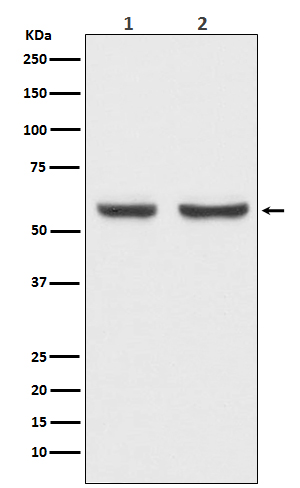xCT Antibody
Rabbit mAb
- 产品详情
- 实验流程
Application
| WB, IF, ICC, IP |
|---|---|
| Primary Accession | Q9UPY5 |
| Reactivity | Rat, Human, Mouse |
| Clonality | Monoclonal |
| Other Names | CCBR1; Cysteine/glutamate transporter; SLC7A11; solute carrier family 7; xCT; |
| Isotype | Rabbit IgG |
| Host | Rabbit |
| Calculated MW | 55423 Da |
| Dilution | WB 1:500~1:2000 ICC/IF 1:50~1:150 IP 1:50 |
|---|---|
| Purification | Affinity-chromatography |
| Immunogen | A synthesized peptide derived from human xCT |
| Description | Sodium-independent, high-affinity exchange of anionic amino acids with high specificity for anionic form of cystine and glutamate. |
| Storage Condition and Buffer | Rabbit IgG in phosphate buffered saline , pH 7.4, 150mM NaCl, 0.02% sodium azide and 50% glycerol. Store at +4°C short term. Store at -20°C long term. Avoid freeze / thaw cycle. |
| Name | SLC7A11 (HGNC:11059) |
|---|---|
| Function | Heterodimer with SLC3A2, that functions as an antiporter by mediating the exchange of extracellular anionic L-cystine and intracellular L-glutamate across the cellular plasma membrane (PubMed:11133847, PubMed:11417227, PubMed:14722095, PubMed:15151999, PubMed:34880232, PubMed:35245456, PubMed:35352032). Provides L-cystine for the maintenance of the redox balance between extracellular L- cystine and L-cysteine and for the maintenance of the intracellular levels of glutathione that is essential for cells protection from oxidative stress (By similarity). The transport is sodium-independent, electroneutral with a stoichiometry of 1:1, and is drove by the high intracellular concentration of L-glutamate and the intracellular reduction of L-cystine (PubMed:11133847, PubMed:11417227). In addition, mediates the import of L-kynurenine leading to anti-ferroptotic signaling propagation required to maintain L-cystine and glutathione homeostasis (PubMed:35245456). Moreover, mediates N-acetyl-L-cysteine uptake into the placenta leading to subsequently down-regulation of pathways associated with oxidative stress, inflammation and apoptosis (PubMed:34120018). In vitro can also transport L-aspartate (PubMed:11417227). May participate in astrocyte and meningeal cell proliferation during development and can provide neuroprotection by promoting glutathione synthesis and delivery from non-neuronal cells such as astrocytes and meningeal cells to immature neurons (By similarity). Controls the production of pheomelanin pigment directly (By similarity). |
| Cellular Location | Cell membrane; Multi-pass membrane protein. Cell projection, microvillus membrane; Multi-pass membrane protein. Note=Localized to the microvillous membrane of the placental syncytiotrophoblast. |
| Tissue Location | Expressed in term placenta and primary term cytotrophoblast (PubMed:34120018). Expressed mainly in the brain, but also in pancreas (PubMed:11417227). |
Research Areas
For Research Use Only. Not For Use In Diagnostic Procedures.
Application Protocols
Provided below are standard protocols that you may find useful for product applications.
终于等到您。ABCEPTA(百远生物)抗体产品。
点击下方“我要评价 ”按钮提交您的反馈信息,您的反馈和评价是我们最宝贵的财富之一,
我们将在1-3个工作日内处理您的反馈信息。
如有疑问,联系:0512-88856768 tech-china@abcepta.com.
¥ 1,500.00
Cat# AP91476























 癌症的基本特征包括细胞增殖、血管生成、迁移、凋亡逃避机制和细胞永生等。找到癌症发生过程中这些通路的关键标记物和对应的抗体用于检测至关重要。
癌症的基本特征包括细胞增殖、血管生成、迁移、凋亡逃避机制和细胞永生等。找到癌症发生过程中这些通路的关键标记物和对应的抗体用于检测至关重要。 为您推荐一个泛素化位点预测神器——泛素化分析工具,可以为您的蛋白的泛素化位点作出预测和评分。
为您推荐一个泛素化位点预测神器——泛素化分析工具,可以为您的蛋白的泛素化位点作出预测和评分。 细胞自噬受体图形绘图工具为你的蛋白的细胞受体结合位点作出预测和评分,识别结合到自噬通路中的蛋白是非常重要的,便于让我们理解自噬在正常生理、病理过程中的作用,如发育、细胞分化、神经退化性疾病、压力条件下、感染和癌症。
细胞自噬受体图形绘图工具为你的蛋白的细胞受体结合位点作出预测和评分,识别结合到自噬通路中的蛋白是非常重要的,便于让我们理解自噬在正常生理、病理过程中的作用,如发育、细胞分化、神经退化性疾病、压力条件下、感染和癌症。






